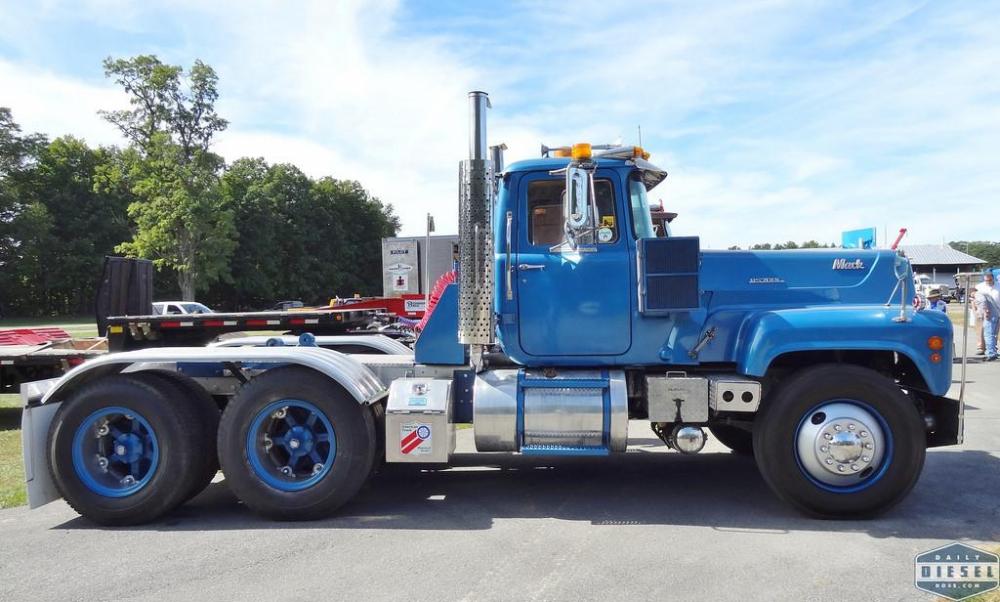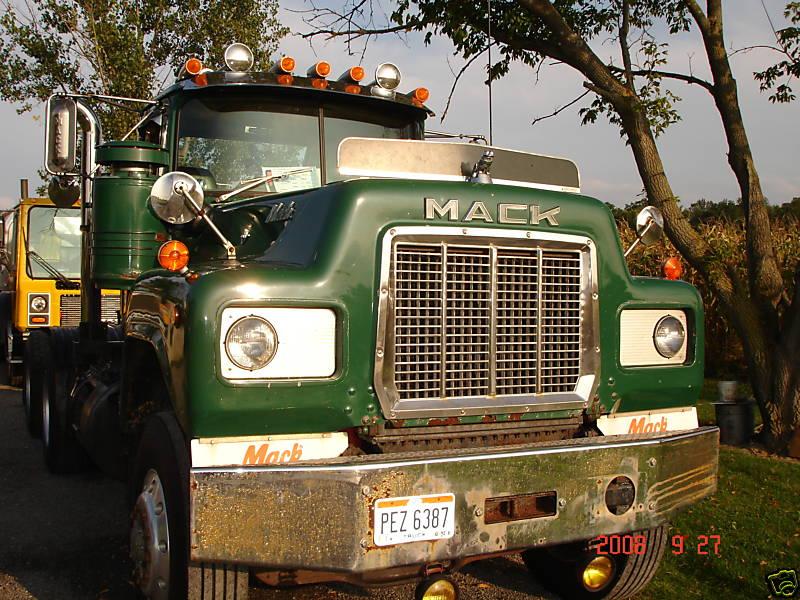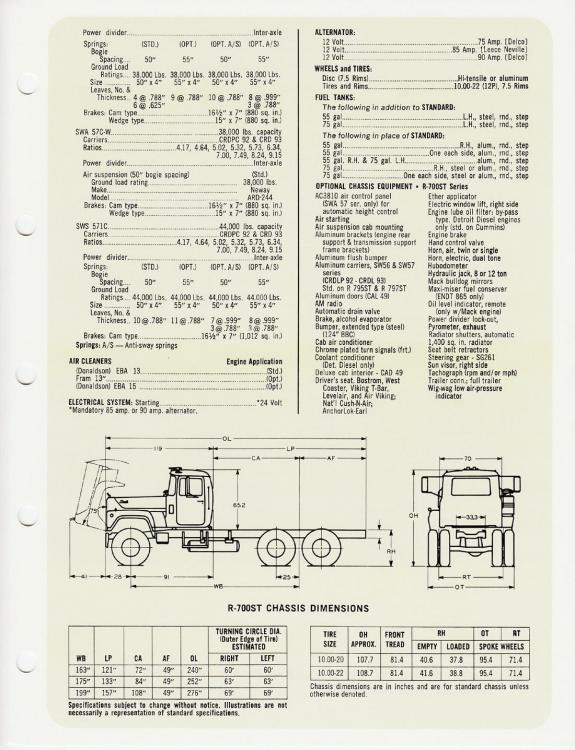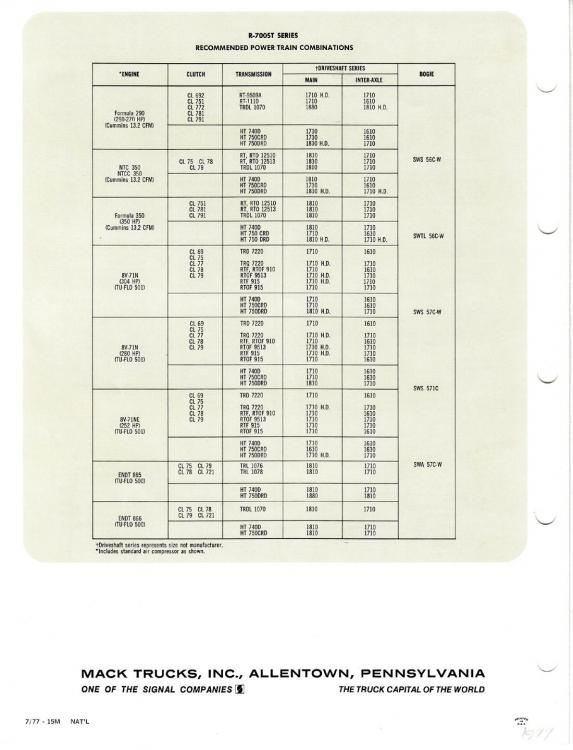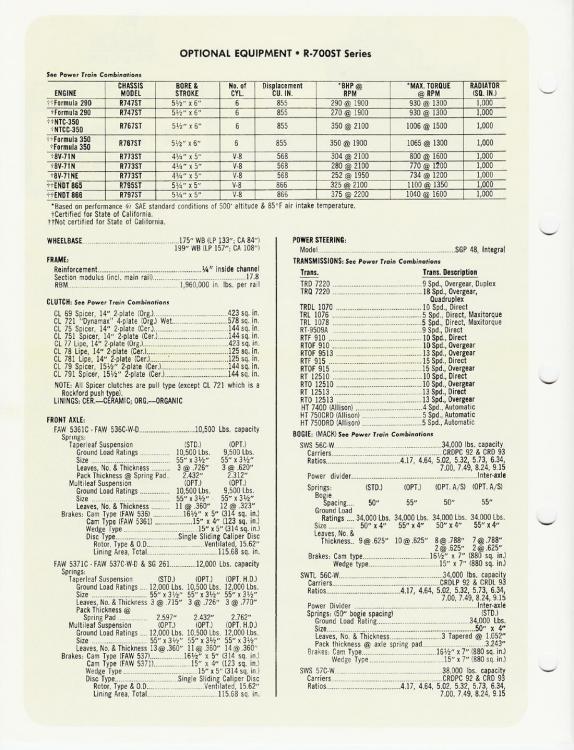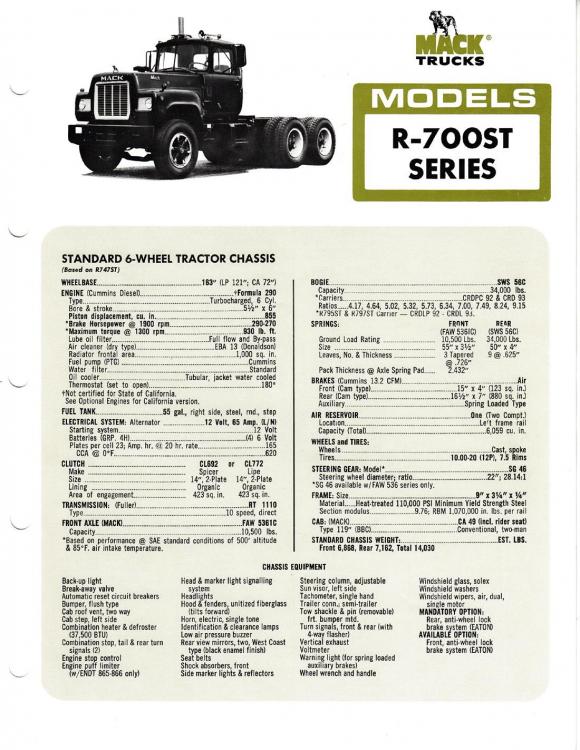-
Posts
242 -
Joined
-
Last visited
-
Days Won
1
Content Type
Profiles
Forums
Gallery
Events
Blogs
BMT Wiki
Collections
Store
Everything posted by Whiskymack
-
Thanks. That would be great. As well as being practical and designed to last trucks also had character back then. They all look a bit the same now, like big cars! Looking forward to the pics but no hurry. I've got several Macks on the bench still!
-
Great looking truck and a nice project to get into.. These are my favourite Autocars. I have one on my list of to do model projects. I have already 3D printed a hood for it but have got a bit hung up on how the front end goes together. Would you be able to take some pics with the hood up? I'm trying to get a look at the frame horns and Radiator mounting but there are so few of these around now that getting any detai is almost impossible.
-
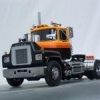
BBC/Hood length RS771LS
Whiskymack replied to Whiskymack's topic in Antique and Classic Mack Trucks General Discussion
Yes, that's just what I was looking for. Thank you. -

BBC/Hood length RS771LS
Whiskymack replied to Whiskymack's topic in Antique and Classic Mack Trucks General Discussion
All the 771's have this modification so it must have been factory. I guess that they were so few in number that it was not economical to produce a longer hood so they came up with the cowl extension instead. You know me, I like figures so I was hoping to find out exactly how many inches were added! -
Does anyone know the BBC dimension for the Detroit Dozen RS771? It's longer than the standard RS700 and you can see there's an infill between the cowl and hood. I know these are rare beasts but I was hoping that maybe someone has access to one and could measure that extra cowl infill or that there are some figures available somewhere. Another model project.
-
https://www.truckpaper.com/listings/trucks/for-sale/192800269/1971-mack-rs700l Beautiful! Price tag to match.
-
Sorry, I think I muddied the waters because I thought we were talking about RW 1 and RW 2 models whereas we are really talking about RWL/S and RWI. Perhaps the 2nd Generation Super-Liner should have been RMH! So, to summarize; Hayward closed in 81 and all Western model production moved to Macungie or elsewhere. RWS/L Super-Liner continued with split frame. WS/L Cruise-Liner with split frame continued with improvements and cosmetic changes like new grill to match Super-Liner. RS/L Value-Liner continued as was. WS/L Cruise-Liner discontinued in 83, replaced by brand new design MH. RWS/L Super-Liner discontinued in 85 replaced by RWI Super-Liner using MH frame. RS/L Value-Liner discontinued in 87 marking the end of a 2 decade distinctive Western product run. Back to R700's, 865's, 866,s 1000/1005's and E9's. Vlad I see what you mean about the valve covers. It also means that the whole cylinder head casting is a bit different too. Found this video whilst comparing.
-
I don't know much about the detailed differences but I think late production 865's and 866's may have looked similar to the E9. The obvious difference is that the E9 had Chassis Mounted Charge Air Cooling which meant there was an aftercooler in front of the radiator along with the piping that went with it. Can we see some models?
-
Misleading publicity from Mack! I took a look at that brochure again. There is a picture of an unbadged Value-Liner labelled as an RD but later in the brochure there is a correctly labelled Western Contractor RD! The brochure is dated 87 so the Value-Liner must have gone by then. Here's a link to it but I can only open it with google Chrome. Firefox or Edge don't seem to like it. Photo: MackConstr87-04 | Mack Construction Trucks 1987 album | modeltrucks25
-
Yes, I've come across the Western Contractor. Wasn't it an RD with the old hood and a lookalike but slightly smaller Western style grill? I remember seeing a Mack construction brochure from the 80's which had both the Western Contractor and the Value-Liner in the lineup so there must have been a period when both models were available.
-
Thats the impression I had got. I would have thought it would have involved too much redesign on a product that had effectively been superceded by the Super-Liner. Incidentally, if RW1 production went to Macungie in 85 it would must have been quite short lived as I thought that the RW2 emerged the following year. It's an interesting period because there seemed to be a bit of product consolidation going on with the demise of Hayward line. The RW2 was a complete redesign with much more of an Eastern pedigree whilst retaining the looks of the old model. Am I right in thinking the Value-Liner also went to Macungie but was discontinued in 87?
-
Just curious about the end production date for the R700. It got a bit of a design revamp in the mid 1970's as we've discussed elsewhere here but it would seem to me that after the introduction of the Superliner there must have been a bit of duplication. The Western RS/RL 700 was discontinued at this time but what about the Eastern R700? All of the larger engine options such as Cummins, Cat, Detroit, 865, 866 and later E9's were available in the Superliner so the R700 would seem a little superfluous in that respect.
-
Sad to say I am! I've followed this thread with interest although I'm a bit out of my depth when it comes to frame depth. It is interesting to see how engineers managed to get standardized parts to fit not standardized frames with spacers and repositioning but it must open a whole can of worms when it comes to rebuilding with donor parts. I had noticed the difference between the frame horns before. The ones on the 88 R and 86 RD go on the outside of the frame rails whereas the ones with the towing eyelet at the bottom go on the inside of the frame rails and I believe were an earlier design. I think they stopped using them on the standard R model around about the time that the corporate bumper came in although they kept them on the U series for a few more years and you can see cutouts at the bottom of the corporate bumper to access the towing eyelets. I've neverseen these cutouts on an R. Before the corporate bumper, the eyelets were below the bottom edge of the shallower bumper. The radiator set up is also a whole topic in itself. Keith pointed out that the radiator mount bolted to tabs on the eyelet frame horns. I think that the engine sat on a cradle which bolted to the back of this mount. When the externally mounted frame horns came in the radiator mount was a kind of wide flattened u shaped crossmember which looks like it bolts to the inside of the frame rails possibly using the same bolts that attach the frame horns. Again the engine was held in a cradle that bolted to the back of this. In both cases the radiator sat quite high. In the Econodyne era the R600 got the tall radiator that dropped down between the frame rails and was held by brackets on the inside of the rails. The engine was held in an asymetrical u shaped crossmember which was mounted behind the radiator. I'm not sure if this was all to do with introduction of CMCAC. I didn't know that the eyelet horns and short radiators were still beng used in 1985. Was a 1985 RD685 still Maxidyne powered with no CMCAC and in that case did the non air cooled Maxidyne 675 stay in production alongside the Econodyne range? This also leads me to start asking questions about the R700 but I'll open a new thread rather than drag this one too far off topic.
-
You are right. There were so many small changes made over the production run of each model. Just looking at the Western R's there were a variety of cab mounts, and other frame fittings over the years. This is what really piques my interest; finding the design differences and trying to work out the logic behind them. I compared some Valueliner pics, pre and post Econodyne. Difficult to know exactly how the extra space for the aftercooler was achieved but this is what I think they did: Moved radiator back a fraction New hood hinge to push hood forward. (A lot of later Valueliners had a gap of about an inch or so between hood and cowl. I always thought this was to allow a bit of travel for air ride cabs but perhaps it was because the hood got moved forward) Possibly a spacer between bumper and frame horns to push bumper forward but very hard to tell from photos. Would need actual trucks and a ruler!
-
To answer my own question it looks like the hood was moved forward based on an '85 Valueliner RS600L spec sheet. The bumper to front wheel centre is given as 29.75 inches whereas it was only 28 on the 70's specsheet. I don't know if the same applied to the Eastern model but it would seem a lot easier to me to extend the bumper mounts and hood hinges than move the cab back.
-
Thanks for the pictures Keith. They really show how little space there is between the shutters and the hood. This seems to be the case with the R600 as well. I think that when the Econodyne engines came out with the charge air cooling Mack added an inch or so to the front of the hood to allow space for the intercooler on the front of the radiator.
-
I think I might have the answer to this. Refer back to this thread: When Mack brought out the Higher mount R700 in the 70's they must have kept the same radiator as on the earlier models. This meant that the lower edge of the radiator top tank became visible at the top of the opening in the hood and the only way to disguise this was to apply a grill. I dont know the exact date of the change but many of these R700's were Cummins powered and may still have had shutters on the radiator. Whatever the case it looks like there is very little space between the front of the radiator and the hood meaning that any grill would have to go on the outside of the hood, tipping with the hood, rather than being mounted to the radiator and staying put when the hood was tilted. Mack already had a grill on the F model so it probably made sense to use this but this grill is dished inwards so it would have clashed with the front of the radiator. The solution was to apply the raised rib or pedestal around the grill which Vlad talks about as this would have brought the grill further forward. You'd have then thought that the same grill would have been applied to the R600 for design continuity but I don't think this happened in the US although in Australia, both R600 and R700 models had the F model grill from sometime in the 80's. All guess work base on looking at photos so feel free to shoot me down.
-

2019 Rubber Duck Truck Reborn???
Whiskymack replied to PaLawman's topic in Modern Mack Truck General Discussion
I love it! Even shunted a police car by the look of the bent bull bar! Is this the truck that was rebuilt from an old Flintstone some years back? -

St. Louis Mack Trucks
Whiskymack replied to autocardc's topic in Antique and Classic Mack Trucks General Discussion
I'm with you on that. The RS/RL's were definitely lookers. I think Hayward came up with a better solution to the fender/tyre gap with the lower mounted fenders on the later Western Hood. The deeper fender on the Eastern models looks a little bit awkward in my opinion but I still think that, overall, the hood sitting higher was an improvement and actually brought the Eastern models closer to the Western in terms of appearance. Still curious as to why Hayward offered it's long hoods with 6 cylinder Mack motors while the Easterns only seemed to come with Mack V8's or proprietary motors. -

St. Louis Mack Trucks
Whiskymack replied to autocardc's topic in Antique and Classic Mack Trucks General Discussion
The hood is different too. It has deeper fenders; the top of the wheel arch is roughly in line with the centre of the headlights on this hood but is much closer to the top of the headlights on the shallower hood. I don't think this is down to R or RD series because I think Mack changed the R700 design sometime in the mid 70s so all R700's from this point had the raised cab and deeper fenders. I've attached some scanned spec sheets for a 1970 R700 and a 77 R700. The cab height above frame is 61.3 inches on the 70 model and 65.2 for the 77. (This compares to 66 for the RS trucks). My guess is that as the number of horses increased so did the need for greater cooling and the raised cab perhaps allowed for bigger rads and better airflow. Some Australian trucks have had the cabs raised even further to this end. I may be wrong though! I also noticed that all the engine options for both 70 and 77 are Cummins, Detroit, or V8 Mack with no 6 pot Macks. Does this mean that R700's were not offered with 6 cylinder macks because the RS700's definitely were? I think I must have lifted the 77 scan from this site at some point so apologies and thanks to whoever posted it originally. R700LST.pdf -

1964 C615
Whiskymack replied to Prowrench's topic in Antique and Classic Mack Trucks General Discussion
Sorry, Getting in a mess with the multiquoting! Masury sounds like quite an individual! I think It's time for a re-read of Montville. It looks like the rubber insulated spring mount stayed in production for a long time if it was still being used on the C series in 1963. Was it offered as an option alongside the collar and pin and standard shackle or was it replaced by these? Here's a picture of the hanger on the above C series. It looks pretty much the same as the one in Vlad's picture. -

1964 C615
Whiskymack replied to Prowrench's topic in Antique and Classic Mack Trucks General Discussion
Seen in the UK in 2013
BigMackTrucks.com
BigMackTrucks.com is a support forum for antique, classic and modern Mack Trucks! The forum is owned and maintained by Watt's Truck Center, Inc. an independent, full service Mack dealer. The forums are not affiliated with Mack Trucks, Inc.
Our Vendors and Advertisers
Thank you for your support!




